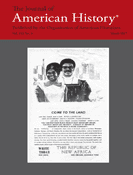-
Views
-
Cite
Cite
Robert Lee, Accounting for Conquest: The Price of the Louisiana Purchase of Indian Country, Journal of American History, Volume 103, Issue 4, March 2017, Pages 921–942, https://doi.org/10.1093/jahist/jaw504
Close - Share Icon Share
Extract
The price of the Louisiana Purchase has long signaled one of world history's most spectacular real estate windfalls. Henry Adams called it “unparalleled, because it cost almost nothing.” At the sesquicentennial of the purchase, Bernard DeVoto cited the “fantastically small” cost and dubbed it the most important “event in all American history.” A recent historian of the deal uncovered a fanciful offer to take the land off federal hands at cost, “about 4 cents an acre,” and he mused that those making the offer “would have made a killing.” For generations of students, the $15 million price tag has embodied the story of a bargain that doubled a national domain for pennies on the acre, glossing over the fact that France had precious little real estate to sell.1
Over most of the area covered by the Louisiana Purchase the United States bought a territorial abstraction known to adherents of the doctrine of discovery as preemption. As legal scholars and historians have pointed out, preemption overlaid indigenous occupancy rights with exclusive authority to obtain Indian title by conquest or contract. For $15 million, the United States increased its buy-in to this colonial confidence game, and at no great discount. Napoleon Bonaparte reportedly considered Louisiana worth 50 million francs, making the American promise of 60 million francs in principal plus 20 million in debt relief hardly a masterstroke of negotiation. What ultimately made the 1803 purchase different played out over the following years, through acquisitions of Indian country by treaties and agreements that remade this region as a place to build and reproduce communities. A violence-backed power imbalance favored U.S. negotiators but never eliminated Indian leverage completely, resulting in a piecemeal take-over Stuart Banner aptly describes as “conquest by contract.”2





